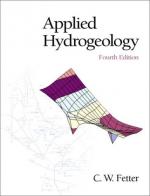|
This section contains 399 words (approx. 2 pages at 300 words per page) |
The saturated zone encompasses the area below ground in which all interconnected openings within the geologic medium are completely filled with water. Many hydrogeologists separate this zone into two subzones: the phreatic zone and the capillary fringe.
The phreatic zone is the area in which the interstitial water will freely flow from pores in the geologic material. Water in the pores of the phreatic zone is at a pressure greater than atmospheric pressure. Lying above, and separated from the phreatic zone by the water table, is the capillary fringe. Capillary action within the voids of the geologic medium causes water to be drawn upward from the top of the phreatic zone or captured as it percolates downward from the overlying unsaturated zone. Unlike the phreatic zone, however, the capillary action causes the water in the pores to have a pressure that is lower than atmospheric pressure. While the pores of both subzones are saturated, the different pressures in each cause the water to behave differently. Water within the phreatic zone will readily flow out of the pores while the negative pressures within the capillary fringe tightly hold the water in place. It is water from the phreatic zone that is collected and pumped from wells and flows into streams and springs.
Water within the phreatic portion of the saturated zone moves through the interconnected pores of the geologic material in response to the influences of gravity and pressure from overlying water. Rates of groundwater movement within the saturated zone ranges from a few feet per year to several feet per day depending upon local conditions. Only in larger fractures or karst systems do velocities approach those seen in surface flows.
The saturated zone extends downward from the capillary fringe to the depth where rock densities increase to the point that migration of fluids is impossible. In deep sedimentary basins, this may occur at depths of approximately 50,000 feet. At these extreme depths, the voids are no longer inter-connected or not present.
Localized saturated zones can occur within the unsaturated zone when heterogeneities within the geologic medium cause differential downward percolation of water. Specifically, layers or lenses of low permeability, such as clay or shale, can retard the movement of water in the unsaturated zone and cause it to pool above the layer. This forms a perched zone of saturation.
See Also
|
This section contains 399 words (approx. 2 pages at 300 words per page) |


